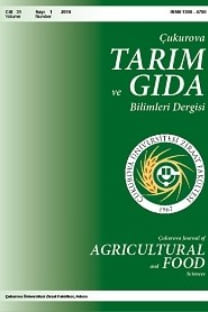Pepino (Solanum muricatum) Meyvesinin Aroma Maddeleri Bileşimi
Bu çalışmada, Miski çeşidi pepino (Solanum muricatum) meyvesinin genel özellikleri ve aroma maddeleri bileşimi araştırılmıştır. Meyvedeki aroma maddeleri diklorometan çözgeni yardımıyla sıvı-sıvı ekstraksiyon yöntemiyle ekstrakte edilmiştir. Aroma maddelerinin miktarlarının belirlenmesinde gaz kromatografisi, tanımlanmalarında ise gaz kromatografisi-kütle spektrometresi (GC-MS) kullanılmıştır. GC-MS analiz sonuçlarına göre Miski çeşidi pepinoda 12 adet alkol, 7 adet keton, 3 adet lakton, 8 adet aldehit, 12 adet uçucu asit, 7 adet ester ve 1 adet terpen olmak üzere toplam 50 adet aroma maddesi belirlenmiştir. Aroma maddelerinin toplam miktarı 12 893 µg/kg’dır. Bu bileşikler içerisinde asitler en baskın olarak belirlenmiş ve bunları sırasıyla esterler ve aldehitler izlemişlerdir. Esterler meyvemsi aromadan sorumlu önemli aroma maddeleridir. Miski çeşidi pepinoda sırasıyla bütil asetat, 4-pentil asetat ve metil-3-metil-2bütanoat miktar olarak öne çıkan ester bileşikleridir.
Anahtar Kelimeler:
Pepino, aroma maddeleri, sıvı-sıvı ekstraksiyon, GC-MS
Aroma Compounds of Pepino (Solanum muricatum) Fruit
In this study, the aroma composition of cv. Miski pepino (Solanum muricatum) fruit was investigated. The aroma compounds present in the fruit were extracted by liquid-liquid extraction method with the use of dichloromethane as a solvent. Gas chromatography was used for quantification and GC-mass spectrometry was used for the identification of aroma compounds. According to the results of GC-MS analysis; a total of 50 aroma compounds were identified including 12 alcohols, 7 ketones, 3 lactones, 8 aldehydes, 12 volatile acids, 7 esters and a terpene. Total amount of aroma compounds was calculated as 12 893 µg/kg. In these compounds, acids are the most dominant volatile compounds followed by esters and aldehydes. Esters are important aroma compounds responsible for fruity aroma. Butyl acetate, 4pentyl acetate and methyl-3-methyl-2-butanoate are the quantitatively prominent ester compounds respectively in cv. Miski pepino.
Keywords:
Pepino, aroma compounds, liquid-liquid extraction, GC-MS,
___
- Ahumada, M., Cantwell, M., (1996). Postharvest studies on pepino dulce (Solanum muricatum Ait.): maturity at harvest and storage behavior. Postharvest Biol Tech 7: 129-136.
- Beaulieu, J.C., Grimm, C.C., (2001). Identification of Volatile Compounds in Cantaloupe at Various Developmental Stages Using Solid Phase Microextraction. J Agric Food Chem 49: 1345-1352.
- Burdock, G.A., (2009). Fenaroli's Handbook of Flavor Ingredients, Sixth Edition, CRC pres, London.
- Cabaroğlu, T., Selli, S., Erten, H., Canbaş, A., (2004). Kabuk Maserasyonunun Bornova Misketinden Elde Edilen Şıradaki Aroma Maddeleri Üzerine Etkisi. Gıda 29(3): 195-201.
- Çavuşoğlu, A., Erkel, E.İ., Sülüşoğlu, M., (2009). The effect of climatic factors at different growth periods on pepino (Solanum muricatum Aiton) fruit quality and yield. J Food Agric Environ 7 (2) : 551-554.
- Ersoy, N., Bağcı, Y., (2011). Altın Çilek (Physalis peruviana L.), Pepino (Solanum muricatum Ait.) ve Passiflora (Passiflora edulis Sims) Tropikal Meyvelerinin Bazı Fizikokimyasal Özellikleri ve Antioksidan Aktiviteleri. Selçuk Tar Gıda Bil Der 25 (3): 67-72.
- ISSN: 2636-7874
- Başlangıç: 1973
- Yayıncı: Çukurova Üniversitesi
Sayıdaki Diğer Makaleler
Özkan GÜĞERCİN, Nafi BAYTORUN, Deniz Levent KOÇ
Etçi Tip Oğlak ve Kuzularda Besi Performansı ve Et Veriminin Karşılaştırılması
Kadriye HATİPOĞLU, Jerry AGOSSOU, Nazan KOLUMAN
Süt Sığırcılığında Refah İstekleri ve Kritik Kontrol Noktaları
Serap GÖNCÜ, Nazan KOLUMAN, Uğur SERBESTER, Murat GÖRGÜLÜ
Türkiye’de Susam Üretim ve Dış Ticaretinde Gelişmeler
Ham ve Rafine Fındık Yağlarının Yağ Asitleri Bileşimi
Songül KESEN, Ahmet Salih SÖNMEZDAĞ, Haşim KELEBEK, Serkan SELLİ
Pepino (Solanum muricatum) Meyvesinin Aroma Maddeleri Bileşimi
Keçilerde Deri Pigmentasyonunun Fizyolojik Adaptasyon Mekanizmaları Üzerine Etkileri
